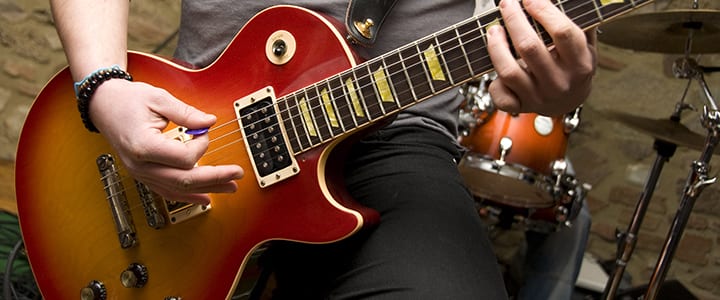 When you’re learning guitar, make sure you don’t shy away from learning music theory. While it may seem complex to a beginner, it will help you take your playing to a whole new level. Here, Chicago, IL. guitar instructor Morgan S. shows you how you can use guitar theory to boost your playing…
When you’re learning guitar, make sure you don’t shy away from learning music theory. While it may seem complex to a beginner, it will help you take your playing to a whole new level. Here, Chicago, IL. guitar instructor Morgan S. shows you how you can use guitar theory to boost your playing…
This article will show you how you can apply guitar theory to your creative style, to what you already know about guitar, and to your ear to hear common patterns and themes in music from your favorite artists and bands.
Overall, this article will show you how to use guitar theory to solidify what you already know about guitar, with a new learning method that uses theory as a linguistic tool and as a foundation to help you achieve your music goals.
How Guitar Theory Boosts Your Playing
While I’ve been playing guitar for 10 years, I have only applied what I know about guitar theory for the last five years. I found that I could apply what I know about guitar to learn more about theory and in turn, use theory to learn more about the guitar.
I learned scales and the names of the notes on the guitar, but I never saw the connection. Learning guitar theory has taught me to know the key I’m using to play. When you know the key, you know the appropriate notes. If you know the appropriate notes, you can avoid the sour notes! This is incredibly useful to improvise a guitar solo.
Theory is important for guitarists for many reasons. I’m sure you’ve had moments where you’ve thought “wow that riff sounds great, what’s a good bass line to play over that instead of the root notes?” Guitar theory can help you in these situations. Knowing the key tells you what type of notes to play, what type of chords to create, and how you can manipulate chords to tailor your style.
How to Use Guitar Theory
Take a look at a G major barre chord. Your first, third, and fourth finger play a G power chord, playing the notes of G, D, and an octave G. Continuing with the rest of the chord, your second finger plays a B note. Your first finger then barres the rest of the third fret, covering another set of notes: D and G.
* So collectively, playing a G major chord is simply playing a combination of octaves between the notes of G, B, and D.
G,B, and D are the first, major third, and fifth of a G major scale, otherwise known as a major triad. So if G,B, and D are taken care of in a G major scale, we’re left with A, C, E, and F#. So, G-1, A-2, B-3, C-4, D-5,E-6, and F#-7th.
Not only do we have seven notes to choose from if we want to solo in G major, we can also use these seven notes to see what kind of chords we can make in G major.
Every chord we play in G major HAS to have those exact notes. Not Eb, not C#.. the only sharp note is the sharp F (start looking at the circle of fifths linked with the article).
Here’s a video to help you understand how to play a G major barre chord:
As we go along the G major scale, let’s list the types of chords for each note:
G is obviously major, A is minor, A major would have C# as the third, but we need to keep our C natural since we’re in the key of G major.
Next is B minor, again Eb would be the third of B major, but we need to flat that major third to D to stay within G major. Keep applying the rules to each note; eventually, you can list your chords for G major like this:
- G – Major
- A – Minor
Now, within any of these chords, you can manipulate single notes to create different versions of a chord. For example, the G major. G, B, and D. How about we throw in an F# to give it a sweet, major seventh sound?
More: Guitar Theory Basics: Understanding Keys
Use Guitar Theory to Learn New Songs
Another reason I like guitar theory is because you can use it to learn a song by another artist. When you know the key, you can
When you know the key the artist is using, you can see when he or she might step out of a key, or change a melody to activate the rules of theory.
I love this because it gives you an opportunity to learn from your favorite guitarists and recognize when they challenge the art of writing music.
This is the most valuable part of guitar theory (in my opinion); it’s such a great tool to use to learn from others.
Guitar Theory: Your Secret Weapon
Theory is almost like the language of music, and when you know theory while listening to your favorite songs, you can understand the artist and see what he or she is telling you through melodies and chords.
Work with your teacher and ask about guitar theory. Then, it’s up to you to listen and learn technique, styles, and methods from your favorite songs and artists!
 Post Author: Morgan S.
Post Author: Morgan S.Morgan teaches bass guitar, drums, guitar, and music theory in Chicago, IL. He is working towards his Associates Degree in fine arts at the College of DuPage and studying music business at Columbia College Chicago. Learn more about Morgan here!
Maile Proctor

